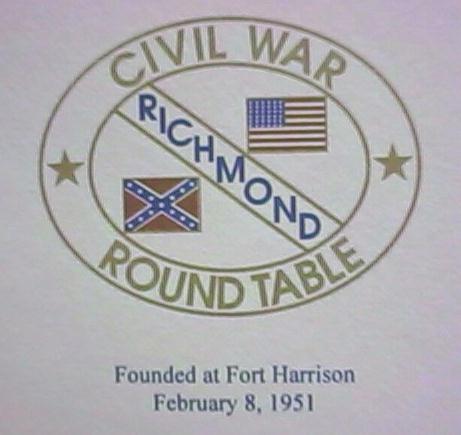


November 1999
Robert E.L.Krick, President John M.Coski, editor 10407 Leander Dr. 1201 E.Clay St. Glen Allen, VA 23060 Richmond, VA 23219 NOVEMBER 1999 PROGRAM CHRIS FONVIELLE THE LIFE AND TIMES OF LT. CDR. WILLIAM B. CUSHING USN 8:00 p.m., Tuesday, October 12, 1999 Boulevard United Methodist Church 321 N. Boulevard (Corner of Boulevard and Stuart Ave.) Enter basement door from Boulevard side. William Barker Cushing was bonn on November 4,1842 near The present-day town of Delafield, Wisconsin. The untimely death of his father at age 4 moved the family to Fredonia, Ne%v York. A rambunctious, hot-headed young man who was fond of pranks grew into a natural born leader. Upon entering the U. S. Naval Academy at age fourteen, Cushing's attitude put him at odds with faculty members which brought on his resignation on March 23, 186 1. But not a week had passed before young Cushing found himself in the U. S. Navy as an acting master's mate after a friend spoke on his behalf. Mr. Fonvielle will share wine us Cushing's daring escapades behind Confederate lines, including the mission that made him a national hero. Chris E. Fonvielle, Jr. holds degrees from the University of North Carolina, East Carolina University, and his Ph. D. in American history with emphasis in Civil War Studies from the University of South Carolina. He has been a curatorial consultant for the Cape Fear Museum as well as Museum Curator for the Blockade Runners of the Confederacy Museum. Twice he has written the feature article in Blue & Grey Magazine, and his first book was the Wilmington Campaign: "Last Rays of Departing Hope" This is his second appearance for the Richmond Civil War Round Table. Important notice for those going on the Fall Field Trip: The bus will leave Saturday, November 6, at 7:30 a.m. from the Brook Run shopping center, located on the west side of Brook Rd. (US 1) north of Azalea Rd. and just north of I-95 interchange with US 1. Meet the bus near the earthworks located at the northeast corner of the shopping center. Review of October Program by R. Danny Witt Richmond Civil War Round Table member Scott Mauger delivered a lively talk on the men who composed the cabinet of Jefferson Davis. Of the 18 men who served in the cabinet between February 1861 and May 1865, three each were born in Virginia and Alabama, and two each in Georgia, North Carolina, and Kentucky. Four of the cabinet members were foreign born. The average age in 1861 was 42. All but two members of the cabinet were lawyers by profession. Vice President Alexander 11. Stephens served the longest, from February 1861 until he was arrested at home the day after Davis was captured. General Gustavus Woodson Smith had the shortest tenure - three days as interim secretary of war. Judah P. Benjamin, of Louisiana, was the only man to serve in three different posts: attorney general, secretary of war, and secretary of state. While none of the secretaries died in office, the first cabinet member to die after the war was the grandson of Thomas Jefferson, George Wythe Randolph. The only member of the cabinet to be captured with Davis was also the last survivor, the only postmaster general, Texan John H. Regan. Needless to say, Scott knew where all of the cabinet members are buried and has been to all of the graves, except for Benjamin's in Paris... but he has a photograph. Secretary of state was a prestigious job for prominent statesmen. The ambitious Georgian Robert A. Toombs served until he resigned to become a general late in 186 1, and was followed by another man with his eyes on the r)residencv, Virginia's Robert Mercer Taliaferro Hunter. After the Irish-born editor William M. Browne's brief interim term, the office fell to Judah P. Benjamin. Serving as secretaries of the War Department were (in succession) Leroy Pope Walker, of Alabama, Judah P. Benjamin, George Wythe Randolph, of Virginia, Gustavus Smith, Virginian James A Seddon and General (and former United States vice president) John C. Breckinridge, of Kentucky. In contrast to the revolving door at the State and War departments was the Treasury Department which was held by two South Carolinians, the Swiss-born Christopher G. Memminger and the Confederacy's financier, George A. Trenholm. Along with the well known Southern statesmen who served in the cabinet were a number of lesser known names. The brother of Braxton Bragg, North Carolinian Thomas Bragg, served as attorney general for only for four months, but he left one of the few wartime diaries describing the inner workings of the cabinet. He was followed in the office by Thomas Hill Watts, of Alabama, Wade Keyes, Jr., of Alabama, and North Carolinian George Davis who served until the fall of the Confederate government. Last but not least was Secretary of the Navy, Stephen Russell Mallory, or Florida. Considered by many historians as one of the best Confederate cabinet members, the Caribbean-born Mallory was not only responsible for the building of several powerful ironclads, but also played an active role in the development and use of torpedoes and mines.
Membership Dues for 2000 Now is the time to write your dues checks for 2000. If you have not paid by February 1, 2000, your name will be removed from the membership rolls and you will not be able to rejoin (with the payment of the additional $15 initiation fee) until 2001.
